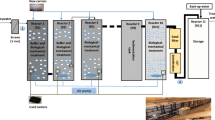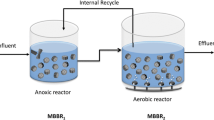Abstract
The investigation aimed to present mathematical models for describing the dynamic behavior of the dissolved organic matter removal and nitrification in the Aerated Submerged Bio-Film (ASBF) for a plug-flow reactor. Based on the experimental data from the batch system of the ASBF pilot plant, mathematical models for the plug-flow reactor were developed to predict dissolved organic matter and ammonia nitrogen removal rates as a function of heterotrophic and autotrophic bacteria populations, dissolved organic matter concentrations, ammonia nitrogen concentrations, dissolved oxygen concentrations, and temperature. The mathematical models for dissolved organic matter and ammonia nitrogen removal in ASBF include two differential equations reflecting heterotrophic and autotrophic bacteria populations, and a number of kinetic parameters. Consequently, the results present a better insight into the dynamics behavior of heterotrophic and autotrophic biofilm growth and their practical application to wastewater for dissolved organic matter and ammonia nitrogen removal process. The mathematical model for ammonia nitrogen and dissolved organic matter removals present good results for the plug-flow reactor.
Similar content being viewed by others
References
Barnes, D. and P. J. Bliss (1983) Biological control of nitrogen in wastewater treatment. E. & F. N. Spon Ltd.
Choi, Y., D. F. Hayes, and K. Johnson (2007) Mathematical model for a batch aerated submerged biofilm reactor for organic carbon and nitrogen removal. Kor. J. Chem. Eng. 24: 633–640.
Park, H. O., S. Oh, R. Bade, and W. S. Shin (2010) Application of A2O moving-bed biofilm reactors for textile dyeing wastewater treatment. Kor. J. Chem. Eng. 27: 893–899.
Choi, Y., Johnson, K., D. F. Hayes, N. Sung, and H. Xu (2010) Dissolved organic matter and nitrogen removal by advanced aerated submerged bio-film reactor. Desalin. 250: 368–372.
Vayenas, D. V. and G. Lyberatos (1994) A novel model for nitrifying trickling filters. Wat. Res. 28: 1275–1284.
Argaman, Y., G. Papkov, A. Ostfeld, and D. Rubin (1999) Singlesludge nitrogen removal model: Calibration and verification. J. Envir. Engr. 125: 608–617.
Bernardes, R. S., H. Spanjers, and A. Klapwijk (1999) Modeling respiration rate and nitrate removal in a nitrifying-denitrifying SBR treating domestic wastewater. Bioresour. Technol. 67: 177–189.
Cao, G., Q. Zhao, X. Sun, and T. Zhang (2002) Characterization of nitrifying and denitrifying bacteria co-immobilized in PVA and kinetics model of biological nitrogen removal by co-immobilized cells. Enz. Microbial. Technol. 30: 49–55.
Sen, D., C. W. Randall, R. R. Copithorn, and T. J. Grizzard (1992) Critical design and process control features to optimize biological nutrient removal in temperature climates. Wat. Sci. Tech. 26: 2237–2240.
Andreottola, G., G. Bortone, and A. Tilche (1997) Experimental validation of a simulation and design model for nitrogen removal in sequencing batch reactors. Wat. Sci. Tech. 35: 113–120.
Reed, S. C. (1995) Natural systems for waste management and treatment. McGraw-Hill, NY.
Johnson, K., L. D. Reaveley, and Y. Choi (2006) Submerged ammonia removal system and method. US patent 7,008,539.
APHA, AWWA, and WPCF (1998) Standard Methods for the Examination of Water and Wastewater. 20th ed., APHA, Washington D. C.
Chapra, C. S. (1997) Surface water-quality modeling. McGraw-Hill, NY.
Fruhen, M., E. Christan, W. Gujer, and O. Wanner (1991) Significance of spatial distribution of microbial species in mixed culture biofilms. Wat. Sci. Tech. 23: 1365–1374.
Hoen, K., M. Schuhen, and M. Köhne (1996) Control of nitrogen removal in wastewater treatment plants with predenitrification, depending on the actual purification capacity. Wat. Sci. Tech. 33: 223–236.
Murat, S., G. Insel, N. Artan, and D. Orhon (2003) Effect of temperature on the nitrogen removal performance of a sequencing batch reactor treating tannery wastewater. Wat. Sci. Tech. 48: 319–326.
Tchobanoglous, G. and F. L. Burton (1991) Wastewater Engineering. McGraw-Hill, NY.
U. S. Environmental Protection Agency (1993) Nitrogen Control. Washington D. C.
Harremöes, P., A. Haarbo, M. Winther-Nielsen, and C. Thirsing (1998) Six years of pilot plant studies for design of treatment plants for nutrient removal. Wat. Sci. Tech. 38: 219–226.
McBean, A. E. and A. F. Rovers (1998) Statistical procedures for analysis of environmental monitoring data & risk assessment. Prentice Hall PTR Environmental Management and Engineering Series. Volume 3.
Author information
Authors and Affiliations
Corresponding author
Rights and permissions
About this article
Cite this article
Han, Y., Johnson, K., Hayes, D. et al. Novel mathematical modeling on pilot-scale of plug-flow aerated submerged biofilm reactor for dissolved organic matter and nitrogen removal. Biotechnol Bioproc E 18, 989–999 (2013). https://doi.org/10.1007/s12257-012-0510-7
Received:
Accepted:
Published:
Issue Date:
DOI: https://doi.org/10.1007/s12257-012-0510-7




